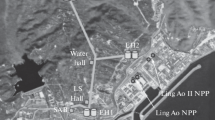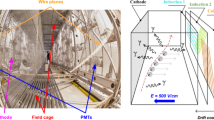Abstract
The DANSS neutrino spectrometer has been collecting data for more than four years, detecting reactor antineutrinos by means of the inverse \(\beta \)-decay (IBD) reaction. The experimental setup is movable being equipped with a lifting device. The analysis of the ratios of IBD positron spectra taken at different distances from the center of the reactor core makes it possible to search for the short-range oscillations of electron antineutrinos due to their transition into a hypothetical sterile state. In addition, the DANSS experiment conducts the reactor power monitoring, using the measured reactor antineutrino counting rate. The presented DANSS results on neutrino oscillations are based on more than 3.5 million IBD events, which were collected from October 2016 to February 2020. The measured positron spectra from the IBD reaction are compared with theoretical predictions. Long-term measurements of the reactor power are also presented. Their comparison with the data provided by the Kalinin NPP staff illustrates the excellent detector capacity for the independent high-precision monitoring of a nuclear reactor.




Similar content being viewed by others
REFERENCES
V. A. Korovkin et al., “Measurement of power output of power reactor by neutrino detection method,” Atomic Energy 65, 169–173 (1988).
A. Mueller et al., “Improved predictions of reactor antineutrino spectra,” Phys. Rev. C 83, 054615 (2011).
P. Huber, “On the determination of anti-neutrino spectra from nuclear reactors,” Phys. Rev. C 84, 024617 (2011).
L. Ludhova, “Overview on solar, geo, and reactor neutrino experiments,” J. Phys. Conf. Ser. 1586, 012034 (2020).
G. Mention et al., “The reactor antineutrino anomaly,” Phys. Rev. D 83, 073006 (2011).
C. Giunti and M. Laveder, “Statistical significance of the gallium anomaly,” Phys. Rev. C 83, 065504 (2011).
K. Olive et al., “(Particle Data Group). Review of particle physics,” Chin. Phys. C 40, 100001 (2016).
A. Serebrov and R. Samoilov, “The analysis of the results of the Neutrino-4 experiment on search for sterile neutrino and comparison with results of other experiments,” JETP Lett. 112, 211–225 (2020).
I. Alekseev et al., “DANSS: detector of the reactor antineutrino based on solid scintillator,” J. Instrum. 11, 11011 (2016).
I. Alekseev et al., “Search for sterile neutrinos at the DANSS experiment,” Phys. Lett. B 787, 56–63 (2018).
I. Alekseev et al., “Digitization of waveforms from photosensors of the DANSS detector,” Instrum. Exp. Tech. 61, 349–354 (2018).
I. Alekseev et al., “DANSS neutrino spectrometer: detector calibration, response stability, and light yield,” Phys. Part. Nucl. Lett. 15, 272–283 (2018).
I. Alekseev, “Measurements of the reactor antineutrinos with the DANSS experiment,” J. Phys. Conf. Ser. 1468, 012156 (2020).
G. Bak et al., “Measurement of reactor antineutrino oscillation amplitude and frequency at RENO,” Phys. Rev. Lett. 121, 201801 (2018).
G. Mention, “The reactor antineutrino anomaly,” J. Phys. Conf. Ser. 408, 012025 (2013).
ACKNOWLEDGMENTS
The DANSS collaboration is grateful to the KNPP administration, as well as its radiation safety department and the nuclear safety and reliability department, for constant help and assistance.
Funding
The construction of the setup and its commissioning were supported by the State Corporation RosAtom as part of governmental contracts nos. N.4kh.44.90.13.1119 and N.4kh.44.9B.16.1006. The operation of the detector and data analysis were supported by the Russian Science Foundation (grants nos. 17-12-01145 and 17-12-01145P).
Author information
Authors and Affiliations
Corresponding author
Additional information
Translated by E. Chernokozhin
Rights and permissions
About this article
Cite this article
Machikhiliyan, I. The DANSS Neutrino Spectrometer: the Results of Reactor Antineutrino Studies. Phys. Part. Nuclei 53, 546–551 (2022). https://doi.org/10.1134/S1063779622020502
Received:
Revised:
Accepted:
Published:
Issue Date:
DOI: https://doi.org/10.1134/S1063779622020502




